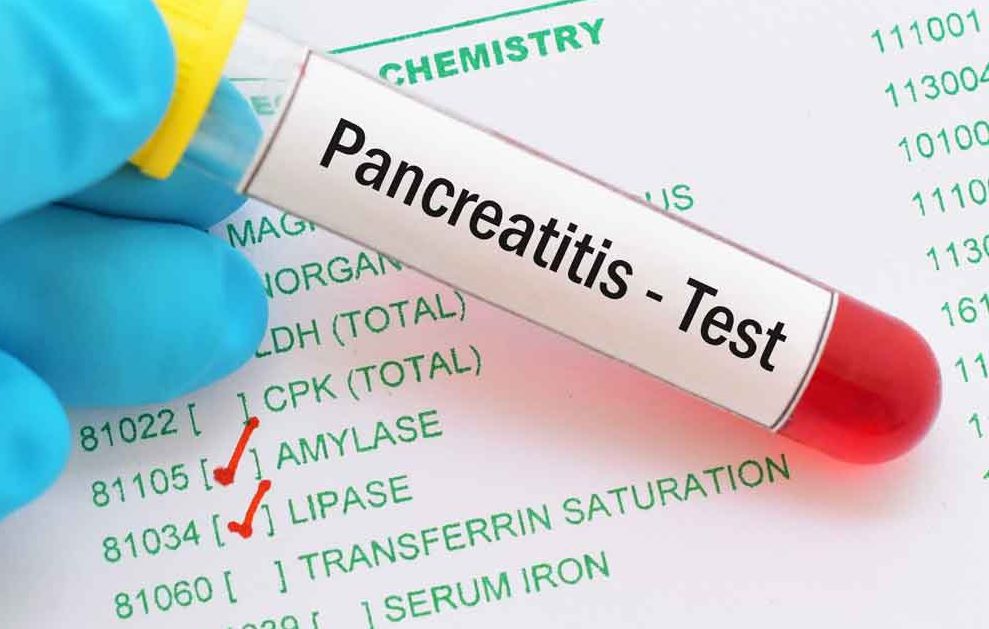Pancreatitis Symptoms

Pancreatitis, inflammation of the pancreas, can cause severe pain and be life-threatening. If you have pancreatitis symptoms, seek immediate medical care.
The pancreas is a gland in your upper abdomen, located behind your stomach and close to the duodenum (the first part of your small intestine). Although only about six inches long, your pancreas is crucial for good health. It produces insulin (which controls how your body uses and stores glucose), and it makes enzymes to digest food in your intestine, allowing nutrients to be absorbed.
When your pancreas is functioning normally, you probably never think about this glandular organ. But if you develop inflammation of the pancreas, a condition known as pancreatitis, the symptoms can be uncomfortable — often including severe pain — and sometimes life-threatening.
YOU MIGHT ALSO LIKE: Symptoms of Exocrine Pancreatic Insufficiency
Are you at risk for chronic or acute pancreatitis?
Pancreatitis can be chronic, occurring over many years, or it can be sudden and acute. The most common causes of both types are gallstones, excessive alcohol consumption, genetic disorders, and injury from some drugs.
Less common causes include infections (especially from viruses or parasites), abdominal injuries, and pancreatic cancer, according to the National Institute of Diabetes and Digestive and Kidney Diseases (NIDDK).
Men are more likely to develop pancreatitis than women. African Americans have a higher risk than other races. The likelihood of developing pancreatitis also increases if you have a family history of pancreatitis or gallstones.
For reasons that aren’t clear, acute pancreatitis is becoming more common, the NIDDK points out. Although it is rare in children, an increasing number of youngsters, as well as adults, are developing the condition. In all, there are about 275,000 hospital stays annually in the U.S. due to acute pancreatitis symptoms and about 86,000 hospital admissions for chronic pancreatitis.
Both chronic and acute pancreatitis are serious health concerns and can lead to complications that are sometimes life-threatening, the NIDDK notes. What’s more, chronic pancreatitis can cause type 2 diabetes, and acute pancreatitis raises your risk of pancreatic cancer.
Talk to your doctor or seek immediate medical care if you have symptoms of pancreatitis.
It’s important to recognize pancreatitis symptoms
Acute pancreatitis is an isolated episode of abdominal pain and other symptoms, and it’s marked by elevations in blood enzyme levels associated with the condition. Chronic pancreatitis is an ongoing, usually painful disease with inflammation-caused irreversible scarring and other damage to the gland. Multiple episodes of acute pancreatitis can lead to the chronic form.
Although less common than the acute form of the disease, chronic pancreatitis tends to worsen over time and lead to permanent damage, the National Pancreas Foundation warns. Eventually, chronic pancreatitis can impair your body’s ability to make hormones and digest food.
Both acute pancreatitis and chronic pancreatitis usually cause pain in your upper abdomen. The pain can be mild or severe, typically worsens after eating, and can spread to your back. It may last for days or even become constant.
Other pancreatitis symptoms can include:
- Vomiting
- Weight loss
- Nausea
- Diarrhea
- Foul-smelling, greasy stools
Some people with chronic pancreatitis may not have symptoms until they develop signs of complications, such as:
- Non-stop abdominal pain
- Malnutrition from food not being digested properly
- Bone fractures from calcium malabsorption
Complications of acute pancreatitis can include infections, internal bleeding, and dehydration.
Get medical care for acute pancreatitis symptoms
People experiencing severe acute pancreatitis symptoms usually appear and feel seriously ill — and their illness may be life-threatening.
The NDDK advises seeking immediate medical help if you or someone you know has these severe pancreatitis symptoms:
- Pain or tenderness in your abdomen that is severe or becomes worse
- Nausea and vomiting
- Chills and fever
- Unusually fast heartbeat
- Shortness of breath
- Jaundice (yellowish color of your skin or whites of your eyes)
Diagnosing and treating pancreatitis symptoms
You may have:
- Blood tests (to check for signs of inflammation, infection, and digestive enzyme levels)
- Stool tests (to look for fat malabsorption)
- Imaging tests, such as CT scans and MRIs
Treatment for both chronic and acute pancreatitis symptoms may include a hospital stay to treat dehydration and severe pain. You may receive nutrition through an IV or feeding tube.
Mild pancreatitis may improve after a few days of rest and treatment. More severe cases may require surgery if gallstones are causing the problem. Your doctor may also drain fluid from your abdomen that can build-up around your pancreas (a pseudocyst), causing pain. Sometimes, damaged tissue is removed from the pancreas.
Ongoing, chronic pancreatitis is usually treated with enzyme pills to help with digestion. You may need vitamin supplements (including B-12 shots), if your body is not absorbing nutrients.
Take control to improve or prevent pancreatitis symptoms
If you have pancreatitis, one of the most important things you can do for your health is to stop drinking alcohol. You’ll lower your risk of acute and chronic pancreatitis. The same goes for smoking. If you are a smoker with pancreatitis, you could increase the odds you’ll develop pancreatic cancer, the NIDDK notes.
While there’s no guarantee a healthy lifestyle will prevent pancreatitis, maintaining a healthy weight — or dropping excess pounds — can help your pancreas stay healthier. In addition, you’ll reduce your risk of gallstones, a top cause of pancreatitis, and lower your risk of type 2 diabetes, which also raises your risk of pancreatitis symptoms.
YOU MIGHT ALSO LIKE: Losing Weight Can Reverse Type 2 Diabetes
Updated:
June 29, 2023
Reviewed By:
Janet O’Dell, RN